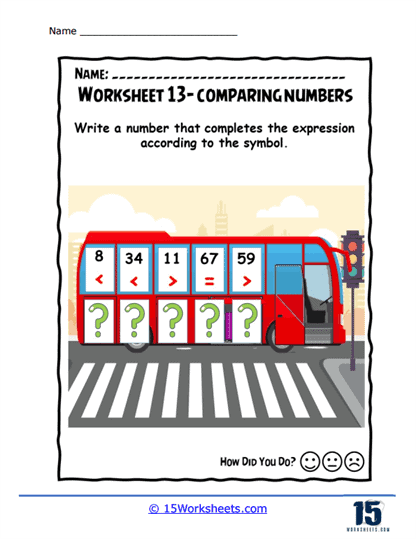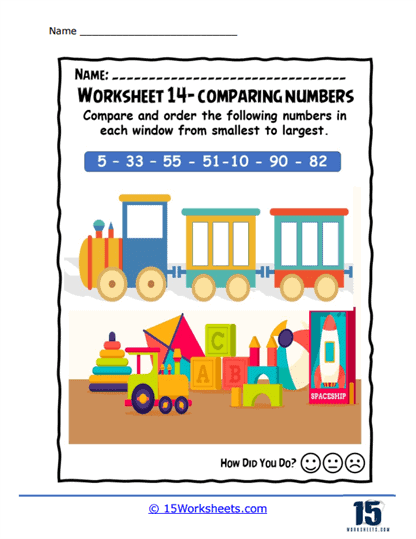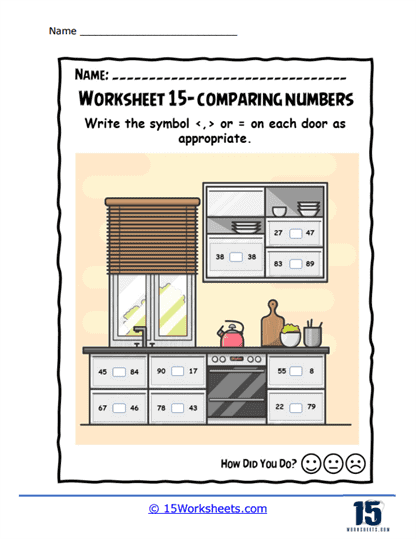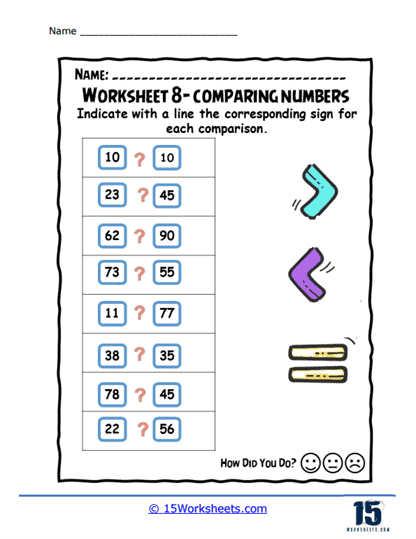Comparing Numbers Worksheets
About These 15 Worksheets
These worksheets will help students develop a solid understanding of number relationships by teaching them how to determine which of two or more numbers is greater, less, or equal. These worksheets come in various forms and cater to different learning levels, from simple exercises involving small numbers to more complex tasks that involve large numbers, decimals, fractions, and even negative numbers. By engaging with these worksheets, students build foundational math skills that are crucial for their academic success and everyday life.
At the most basic level, these worksheets introduce young learners to the concept of greater than, less than, and equal to. These worksheets often feature pairs of numbers, where students are asked to insert the correct symbol (> , < , or =) between the numbers. For instance, a worksheet might present the numbers 3 and 7, and students would need to determine that 3 < 7. These exercises not only teach the mechanical skill of comparing numbers but also foster number sense, helping students understand the relative size of numbers in a concrete way. As students become more comfortable with these comparisons, they can move on to comparing larger numbers, which strengthens their ability to handle more complex mathematical tasks.
Another common type of worksheet activity involves ordering a series of numbers from least to greatest or greatest to least. This type of exercise typically presents a list of three or more numbers, such as 4, 12, 7, and 9, and asks students to reorder them correctly. Ordering numbers helps students to better grasp the continuum of numbers and understand their place in the number line. It also encourages students to think critically about the relationships between numbers and to make comparisons more fluidly and naturally. As students progress, these worksheets can include larger numbers, mixed numbers, or even negative numbers to challenge their understanding further.
These worksheets also include activities that involve comparing numbers in different forms, such as decimals and fractions. For example, a worksheet might ask students to compare the numbers 0.75 and 3/4, requiring them to understand that these two values are equivalent. This type of exercise helps students develop flexibility in their thinking, as they learn to recognize that numbers can be represented in different ways but still hold the same value. Additionally, comparing fractions with different denominators, such as 2/3 and 3/5, teaches students to find common denominators or convert fractions to decimals, which are critical skills for higher-level math. Understanding how to compare fractions and decimals is particularly important as students advance in math, where these concepts become more prevalent.
Some of the worksheets incorporate real-world scenarios that require students to apply their comparing skills in practical contexts. For instance, a worksheet might present a scenario where students need to compare prices of items in a store to determine which is the better deal, or compare distances in a race to see who ran the farthest. These real-world applications help students see the relevance of the skills they are learning and demonstrate how these skills can be applied in everyday situations. Understanding how to compare numbers is a critical life skill, whether it’s comparing prices while shopping, analyzing data in a report, or determining the best value in a financial decision.
As students progress in their math education, they may encounter some worksheets that involve comparing negative numbers. Understanding how to compare negative numbers is an important skill that can initially be challenging for students because it requires them to understand that the number farther to the left on the number line is actually smaller. For example, a worksheet might ask students to compare -3 and -7, where they need to recognize that -7 is less than -3. These exercises help students solidify their understanding of the number line and develop their ability to work with a broader range of numbers. Mastering the comparison of negative numbers is essential for algebra and other higher-level math subjects where negative values are frequently encountered.
These worksheets play a role in teaching students about place value, which is a fundamental concept in understanding the magnitude of numbers. Worksheets might present numbers like 456 and 465, asking students to compare them. In these cases, students must understand that even though the numbers are similar, the position of each digit affects the overall value of the number. Understanding place value is crucial for performing arithmetic operations accurately and for understanding the structure of the number system. It also forms the basis for more advanced topics such as rounding, estimating, and performing calculations with large numbers.
Another variation found within the worksheets involves comparing numbers presented in word problems. These problems require students to read a scenario, extract the relevant numerical information, and then compare the numbers. For example, a word problem might describe two friends collecting seashells, with one friend collecting 42 shells and the other 38. The student would then be asked to determine who has more shells. This type of exercise reinforces reading comprehension alongside math skills, as students must understand the context of the problem in order to solve it. Comparing numbers in word problems is a valuable skill that helps students develop their ability to apply mathematical reasoning in everyday situations.
One of the key benefits of these types of worksheets is that they help students build confidence in their math abilities. By regularly practicing comparing numbers, students develop a sense of mastery over the concept, which in turn builds their overall confidence in math. This confidence is crucial for success in math, as students who feel capable and confident are more likely to persevere through challenging problems and develop a positive attitude towards learning math. Additionally, the skills learned through comparing numbers are foundational for many other areas of math, including arithmetic, algebra, and data analysis, making them essential for long-term success in math.
In the real world, the ability to compare numbers is an essential skill that is used in countless situations. Whether it’s comparing prices while shopping, analyzing data in a business report, evaluating financial options, or making decisions based on measurements, the ability to accurately compare numbers is crucial for making informed decisions. For example, when budgeting, individuals must compare their income to their expenses to ensure they are living within their means. In business, managers often compare sales figures, market trends, and financial statements to make strategic decisions. In science and engineering, professionals must compare experimental data, measurements, and calculations to draw conclusions and make predictions. The ability to compare numbers is also important in everyday tasks, such as determining the fastest route to a destination, comparing nutritional information on food labels, or deciding between different products or services.
The skills developed through comparing numbers worksheets also foster critical thinking and problem-solving abilities. When students learn to compare numbers, they are not just performing a mechanical task; they are engaging in logical reasoning, making judgments, and developing an understanding of numerical relationships. These skills are transferable to many other areas of learning and life, as they help students approach problems systematically, analyze information, and make decisions based on evidence.















